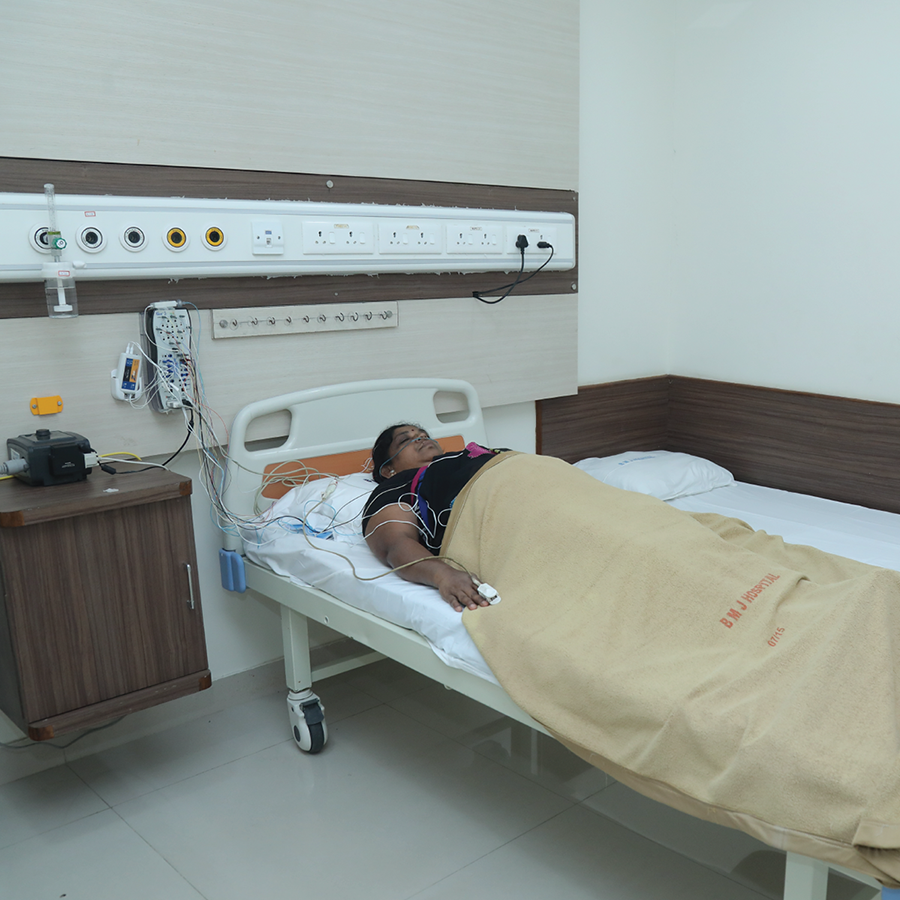Discover the Science Behind Better Sleep with Sleep Study Bangalore
How a Rest Research Study Can Change Your Rest Patterns: Insights and Solutions Available
A rest research study serves as a necessary tool for people seeking to recognize and improve their sleep patterns. It provides an extensive analysis of sleep behaviors and possible conditions. By examining numerous metrics, medical care specialists can recognize underlying concerns that disrupt restorative remainder. This process not only aids in diagnosis yet additionally sets the phase for tailored treatment plans. What insights might a sleep research reveal concerning your very own rest behaviors?
Understanding Sleep Researches: What to Expect
When people prepare for a sleep study, they usually wonder what the experience will entail. These research studies, commonly carried out in a rest facility, purpose to keep an eye on numerous physical criteria throughout sleep. Upon arrival, individuals are welcomed by experienced professionals who assist them through the process. The environment is created to be comfy, permitting an all-natural sleep experience. Individuals might be asked to fill out surveys regarding their sleep behaviors and clinical history, which aids in the assessment.
As the evening progresses, sensors are affixed to the body to track brain waves, heart rate, and breathing patterns. While the arrangement may really feel uncommon, the goal is to collect precise data on the person's rest patterns. The entire procedure is non-invasive and poses no risk to the participant. Eventually, the information gathered throughout the rest study is vital for detecting potential rest conditions and developing reliable treatment plans.
Usual Sleep Disorders Identified Through Rest Researches
Rest research studies play a necessary role in identifying numerous rest conditions that can considerably affect an individual's wellness and well-being. Typical conditions identified through these research studies consist of obstructive rest apnea, defined by duplicated interruptions in breathing throughout sleep, leading to fragmented sleep patterns. One more common condition is sleeplessness, which involves trouble dropping or remaining asleep, frequently resulting in daytime tiredness and damaged functioning. Restless legs disorder (RLS) is also often observed, creating uncomfortable experiences in the legs and an irrepressible impulse to relocate them at night. Narcolepsy, a neurological condition that impacts sleep-wake cycles, is another severe problem identified in sleep researches, bring about extreme daytime sleepiness and abrupt sleep assaults. Ultimately, parasomnias, which encompass abnormal behaviors throughout rest, such as sleepwalking or evening horrors, are additionally kept in mind. Early recognition of these conditions can promote timely intervention and enhance general sleep quality.
The Refine of a Sleep Study: From Prep Work to Results
Although the process of a rest research study might seem intimidating, it is a systematic and organized approach created to gather necessary details concerning an individual's rest patterns. At first, a doctor carries out a thorough evaluation, going over rest background and signs with the client. This evaluation assists identify the specific focus of the study.
Preparation typically entails standards on sleep health and drug changes prior to the study. Clients may be instructed to prevent caffeine and alcohol to assure accurate outcomes. On the evening of the study, electrodes and sensors are placed to keep track of mind task, heart rate, breathing, and activities throughout sleep.
The data gathered is diligently examined by sleep experts, that recognize any patterns or irregularities a measure of sleep problems. Following this analysis, a follow-up consultation is prepared to discuss the searchings for and possible treatment choices customized to the individual's requirements, assisting in better rest quality.

Sorts Of Rest Studies: In-Lab vs. Home Rest Tests
2 key kinds of rest research studies exist: in-lab studies and home rest tests, each providing to various requirements and circumstances. In-lab research studies usually occur in a rest facility where clients are monitored overnight by medical care professionals. This method enables detailed data collection on numerous rest specifications, such as brain activity, oxygen levels, and heart rate. People are typically attached to multiple sensors, giving in-depth understandings into their rest problems, consisting of sleep apnea and narcolepsy.
Conversely, home rest examinations use an easier alternative for people who favor to conduct evaluations in their very own setting. These mobile devices keep an eye on vital metrics like air flow, oxygen saturation, and snoring. While home tests are much less complete than in-lab studies, they function as a sensible option for diagnosing common sleep disorders. Inevitably, the choice between these two kinds of rest studies depends on private preferences, clinical needs, and the seriousness of sleep-related concerns.
Analyzing Your Sleep Study Outcomes: Trick Metrics Described
Comprehending the results of a rest research study is vital for clients looking for insights into their rest great site health and wellness. Key metrics typically evaluated in rest studies consist of the Apnea-Hypopnea Index (AHI), which determines the number of apneas and hypopneas per hour of rest. AHI values assist determine the seriousness of rest Full Report apnea, with higher scores indicating much more considerable problems. Another crucial metric is the overall bedtime (TST), which reflects the general period of rest throughout the research study. Rest performance, the ratio of time spent asleep to time invested in bed, is also vital; higher percents indicate better sleep high quality. Additionally, the portion of rest spent in different phases-- light, deep, and rapid eye movement-- supplies insights into rest style. Comprehending these metrics outfits clients with the understanding required to review their rest patterns with doctor, paving the means for educated choices regarding their sleep health.
Therapy Choices and Referrals Based Upon Your Sleep Research
When a rest study exposes problems such as sleep apnea or various other rest problems, different therapy choices and referrals become offered to enhance overall rest health. For obstructive rest apnea, continual positive air passage pressure (CPAP) treatment is frequently prescribed, giving a constant stream of air to maintain respiratory tracts open throughout rest. Oral appliances may be advised for light to modest instances, repositioning the jaw to avoid airway blockage.
In cases of insomnia, cognitive behavior treatment for insomnia (CBT-I) is usually suggested, focusing on behavioral changes and believed patterns that interfere with sleep. Furthermore, way of living alterations such as weight loss, routine exercise, and staying clear of alcohol or high levels of caffeine before bedtime may improve sleep high quality.
,aspect=fit)
Structure Healthy And Balanced Rest Behaviors: Tips for Better Rest
Structure healthy and balanced rest behaviors is vital for accomplishing restorative rest. Establishing a constant rest routine, restricting screen time prior to bed, and creating a comfy sleep environment can substantially boost sleep top quality. These methods function as foundational steps for people looking for better rest end results.
Establish a Sleep Regimen
Developing a regular rest routine is vital for advertising healthy rest habits and boosting general wellness. Sleep Study Bangalore. A routine sleep timetable, where individuals go to bed and wake up at the very same time every day, reinforces the body's all-natural body clocks. This predictability helps regulate the sleep-wake cycle, causing enhanced sleep quality. Creating a calming pre-sleep ritual, such as analysis or exercising relaxation strategies, can signal the body that it is time to unwind. In addition, optimizing the sleep setting-- by keeping a comfortable this website temperature, reducing noise, and guaranteeing darkness-- can further sustain relaxing rest. By focusing on these methods, individuals can grow a lasting rest regimen that cultivates corrective sleep and adds to much better psychological and physical health
Limit Display Time
As people increasingly depend on displays for enjoyment and interaction, limiting display time before bed has actually become necessary for advertising much better rest. Research shows that direct exposure to blue light given off by gadgets such as tablets, computers, and smart devices can interfere with the manufacturing of melatonin, the hormone in charge of controling sleep. Professionals suggest turning off screens at least one hour before going to bed to boost sleep high quality. Involving in alternate activities, such as practicing or checking out a book leisure techniques, can help people relax and prepare for sleep. By knowingly minimizing display time, people can cultivate much healthier sleep patterns, resulting in improved total well-being and enhanced daytime alertness. Prioritizing this element of sleep hygiene is critical for long-term health.
Develop a Sleep Shelter
Producing a rest refuge can significantly enhance a person's capacity to attain relaxed rest. This atmosphere needs to prioritize convenience and peace, integrating components that promote relaxation. A suitable mattress and pillows are crucial, as they directly effect sleep top quality. Furthermore, the space should be dark, silent, and cool; making use of blackout drapes and white noise machines can promote this atmosphere. Individualizing the space with relaxing shades and fragrances, such as lavender, can better improve leisure. Decreasing clutter also adds to a tranquil setting, permitting for psychological clearness - Sleep Study Bangalore. By attentively designing a sleep haven, people can promote much healthier rest practices and produce a consistent routine, eventually bring about enhanced general well-being and corrective remainder
Frequently Asked Concerns
How much time Does It Require To See Improvements After a Sleep Research study?
Improvements after a sleep study can vary, but numerous individuals start to see positive changes within a couple of weeks. Consistent follow-up and adherence to suggested treatments play crucial functions in attaining optimal results.

Can Children Undergo Sleep Researches, and Exactly How Are They Different?
Yes, children can undertake rest research studies, which differ from grown-up research studies in checking techniques and tools. Pediatric assessments frequently involve child-friendly settings and may consist of moms and dad participation to assure convenience and accurate outcomes.
Are Sleep Studies Covered by Insurance Policy, and What Are the Expenses?
Sleep research studies can be covered by insurance, relying on the policy and clinical requirement. Costs vary extensively, ranging from $300 to $3,000, affected by the kind of research and location of the center.
What Lifestyle Adjustments Can Enhance the Performance of Sleep Research Study Outcomes?

Applying regular rest timetables, minimizing caffeine intake, developing a soothing going to bed routine, and preserving a comfy sleep setting can substantially enhance the efficiency of rest study results, advertising far better sleep high quality and total health.
Exactly how Commonly Should I Repeat a Sleep Research Study for Ongoing Issues?
People experiencing ongoing sleep problems need to consider repeating a rest research each to two years, or as advised by healthcare experts, to check changes and adjust treatment strategies properly based upon their evolving sleep patterns. (Sleep Study Bangalore)
Sleep research studies play a vital duty in recognizing numerous rest disorders that can significantly affect an individual's health and wellness and wellness. Usual problems identified with these research studies include obstructive sleep apnea, defined by duplicated disturbances in breathing throughout rest, leading to fragmented rest patterns. When a sleep research study exposes issues such as sleep apnea or other rest problems, numerous therapy choices and suggestions end up being offered to enhance overall sleep wellness. Developing a regular rest regimen, limiting screen time prior to bed, and developing a comfy sleep environment can considerably improve sleep top quality. Furthermore, maximizing the rest atmosphere-- by maintaining a comfortable temperature level, minimizing noise, and guaranteeing darkness-- can further support relaxing rest.